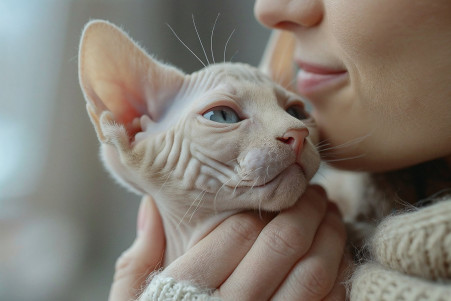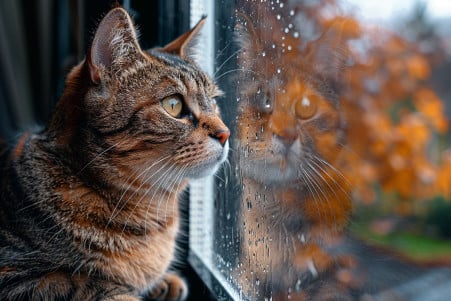Are Ragdoll Cats Hypoallergenic? What to Know About Feline Allergens
8 February 2024 • Updated 8 February 2024

Ragdoll cats, with their beautiful blue eyes and soft, semi-long fur, are often thought of as one of the most docile and allergy-friendly cat breeds, but is this true? Ragdoll cats are not hypoallergenic. While Ragdolls are a low-shedding breed thanks to their lack of an undercoat, they still produce the allergen Fel d 1 in their saliva and dander, which can cause allergic reactions in people who are sensitive to it.
In the sections below, we will explore a number of studies in genetics, veterinary medicine, and allergenology that have worked to dispel the myth of hypoallergenic cats, focusing on Ragdolls.
This research will help to explain the origins of feline allergens and the role that different cat breeds, including Ragdolls, play in the production of these allergens. With this information, you can better determine whether you want to adopt a Ragdoll cat, especially if you’re worried about allergies.
Are ragdoll cats hypoallergenic?
The Protein That Causes Allergies: What Is Fel d 1?
Cats secrete Fel d 1, a protein complex that is the major allergen for as many as 95% of people with cat allergies, and it is most highly concentrated in their saliva, skin, and fur.
When it comes into contact with people who are allergic to it, Fel d 1 binds to IgE antibodies and causes allergic reactions that can range from mild nasal congestion to severe asthma attacks.
The production of Fel d 1 in cats is heavily influenced by genetics, and there is a lot of variation between breeds. Research cited in PMC has shown that neutered male cats and some breeds, including Ragdolls, may produce less Fel d 1 due to genetic factors.
Scientists cited in PMC are working on new ways to reduce allergic reactions to Fel d 1, including creating Fel d 1 blocking antibodies and special diets that can lower the amount of active allergen in cats’ saliva.
However, these interventions are intended to reduce the allergenicity of cats for people who are allergic to them, not to make cats hypoallergenic. Despite common misconceptions, no cat breed is completely hypoallergenic, and misunderstandings about hypoallergenicity often fail to take into account the many factors that influence allergen production and exposure.
Ragdoll Cats: What You Need to Know About Allergen Levels
Ragdoll cats, known for their sweet temperament and semi-long fur, have been the subject of many conversations about their potential as a hypoallergenic pet. A landmark study published in PMC showed that Ragdoll cats had lower levels of the Fel d 1 allergen on their face and chest than other breeds.
This lower amount of allergens could make Ragdolls a better choice for people with allergies. However, it’s important to remember that while Ragdolls have lower levels of dander, they still have the Fel d 1 protein that causes most cat allergies.
In addition to genetics, allergen levels in Ragdoll cats are also influenced by grooming and environmental factors. Regular grooming and a clean environment can help keep allergen levels down. Studies have shown that Ragdoll cats don’t have the dense undercoat that other cats have, which can also help keep allergen levels lower. That said, no cat, including Ragdolls, can be considered hypoallergenic.
Because Ragdoll cats have lower levels of allergens, experts recommend that people with allergies who are considering getting a cat should consider a Ragdoll. However, they also recommend that people who are considering adopting a Ragdoll cat should be prepared to manage allergens in their home.
How to Reduce Cat Allergens in Your Home
While it may seem impossible to coexist peacefully with Ragdoll cats when you have allergies, there are several methods to make it work. You can decrease exposure to Fel d 1 allergens by establishing an “allergy-free” area, particularly in the bedroom, as suggested by Petfinder.
Regularly using a vacuum with a HEPA filter can help, too, as the Humane Society of the United States notes that these vacuums can pick up more fine particles, like cat dander, that a traditional vacuum might just recirculate back into the air.
Air purifiers can also help by capturing airborne allergens, and when used in combination with other methods, they can be a good investment. In addition, you can help reduce the amount of saliva and dander on your Ragdoll cat by bathing them or using cleansing wipes, but you should talk to your vet about how often you should do this to avoid drying out their skin.
New products like allergen-neutralizing cat food, such as Pro Plan LiveClear by Nestlé Purina, are also being developed to help make your home more allergen-friendly, according to Allergic Living. This food is designed to bind to the Fel d 1 in the cat’s saliva and reduce the allergens in their fur.
While this food may not eliminate your allergy symptoms, it’s a step in the right direction when it comes to living with your Ragdoll cat.
When you combine these practical steps with a regular cleaning schedule, you can create an environment that lets you enjoy the benefits of having a pet while minimizing your allergies.
The Heartfelt Connection: How to Manage Allergies and Love for Ragdoll Cats
Pet ownership, including owning Ragdoll cats, has been linked to a variety of mental health benefits. According to NIH News in Health, these benefits include lower stress, better heart health, and improved social and emotional skills.
Unfortunately, for some people, the reality of owning a pet is impacted by pet allergies, which can be stressful and impact quality of life. In fact, a survey conducted by Piri Allergy found that over a third of pet owners have considered giving up their pets due to pet allergies, a choice that can be especially hard because of the emotional support pets provide.
For these people, choosing a Ragdoll cat, a breed that’s known to be more allergy-friendly, may be a way to have the emotional benefits of pet ownership while minimizing the impact of pet allergies. The lower levels of Fel d 1 in Ragdolls may mean that the symptoms of pet allergies will be less severe and less frequent, which could mean that people with mild pet allergies can enjoy a better quality of life.
Of course, people with pet allergies who want to adopt a Ragdoll will need to take other steps to manage their allergies, including using hypoallergenic grooming products, taking antihistamines, and other allergy management techniques.
However, the fact that people can take these steps, along with the Ragdoll’s lower levels of allergens and their sweet, docile nature, shows how important it is to make informed decisions about pet adoption. This, in turn, can lead to a better relationship between people with pet allergies and their beloved Ragdoll cats.
In Conclusion: The Ragdoll Cat Allergy Dilemma
Throughout this deep dive into the world of Ragdoll cat allergens, it has become clear that while these docile cats can’t be considered hypoallergenic, they can be a better option for people with mild cat allergies. By learning about the Fel d 1 protein and the genetic factors that impact its levels, potential pet parents can better understand the complexities of allergies.
This exploration of Ragdoll cats has shown the importance of managing allergens carefully and the promise of scientific research into reducing allergic responses. It has also shown that, as we’ve stressed, the decision to bring a Ragdoll cat into a home with allergies should be made thoughtfully, in consultation with medical professionals, and after careful consideration.
Adopting a pet is a big commitment, especially when health issues are involved. Hopefully, this information will help you make well-informed decisions that will allow you to balance your love of cats with the realities of allergies.


